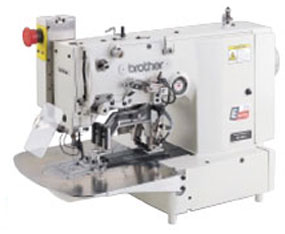Brother KE-484C
Features
- The adoption of an inside motor allows the operator to easily increase the torque to the optimum level for the article being sewn simply by replacing the pulley and PROM. (Available by special order)
- A pneumatic-type thread take-up device is equipped as standard. This device allows you to easily set the thread feeding length at the sewing start to the optimum length (0 to 20 mm) for the material
- Allowance can also be made for the thread trailing length to prevent the thread from pulling out at the sewing start
- The oil supplied to the rotary hook is kept clean at all times, which helps to prevent staining of the thread
- Because this is an electronic pattern tacker, the sewing patterns can be easily changed just by using the operation panel. Changes to line organization can also be made easily
- The presser foot lift amount is a maximum 25 mm. Even extra thick materials can be inserted and removed with space to spare. In addition, the presser foot lift amount can be set to different heights to match the working requirements
- Max. No. of stitches is 20,000. Up to a maximum of 16 user programs can be created, each with its own sewing pattern, enlargement ratio and sewing speed
- Enlargement and reduction of the sewing patterns can be set at a touch using the operating panel. The ratios can be entered either as a percentage or in length (mm). (determined by DIP switch setting)
- Up to 4 cycle sewing patterns can be programmed. Max. 15 patterns/cycle can be programmed
- The operator can select whichever position is easiest to use
- The home position sensor incorporates a non-optical proximity sensor, so the sensor is not subject to operating errors from oil or dust, and cleaning oil and dust from the sensor are also unnecessary
- Bearing brackets have been adopted as the needle bar and thread take-up shaft brackets. These bearings ensure stable and accurate performance with excellent durability, so that stable sewing is possible using threads of up to #0 in thickness
- They improve reliability when sewing under heavy loads, and increase the range of sewing possibilities
- A built-in motor system that is ideally suited to cycle sewing machines has been adopted. This system reduces overall cycle time
- Integration of the motor and the machine head and the adoption of a timing belt make sewing machine operation much quieter and reduce machine vibration
- Periodic adjustment of the belt tension and adjustment of the motor position are no longer necessary. The machine head can also be tilted back to carry out adjustments without the need to remove the belt cover
- The adoption of a timing belt eliminates the problem of belt shavings soiling sewing products
- Complete with table stand and motor
| 

Brother KE-484C
Electronic Lockstitch Pattern Tacker w/Treble Hook
Call For Price:
(800)544-5858
| 
A knife method is used for thread trimming. When the knives are meshing, the movable knife and fixed knife are driven by a pneumatic cylinder. Extra thick threads of up to #0 can be cut accurately regardless of the material of the thread.
|
The speed of the knife is controlled by a pneumatic cylinder which reduces excessive spinning of the bobbin during thread trimming. The thread is held securely from the start of sewing so that stable seams are created.
|
Unlike the heat cutting method, the knife method does not require a heater to be warmed up, so it reduces cycle time. It also saves electricity costs and makes temperature control unnecessary. In addition, the knives are much more durable than the heater wires, so that the knives can accurately cut a greater variety of threads. They are also easier to maintain.
|
The thread wiper is also driven by a pneumatic cylinder. The upper thread can be wiped accurately even under conditions where the thread is difficult to pull out of the material.
|
A pneumatically-driven thread tension release mechanism has been adopted. Compared to cam-type methods, this mechanism provides much stronger thread tension. In addition, the thread tension discs open and close accurately even when high tensions are applied to the upper thread, so that the upper thread trailing length is kept at a constant length and problems at the sewing start are prevented. Stable and accurate thread tightening is provided even under high load conditions, so that good thread tightening can be obtained even when sewing through several layers of material, thereby increasing the range of sewing applications. Plus, a new thread take-up mechanism ensures that the thread tightening is optimum for the material being sewn.
|
|